Producer Theory
1/29
There's no tags or description
Looks like no tags are added yet.
Name | Mastery | Learn | Test | Matching | Spaced |
|---|
No study sessions yet.
30 Terms
Producer Theory
Production: Inputs → outputs
Goal: Profit maximization/cost minimization
Assumptions:
The firm produces a single good
The firm has already chosen which product to produce
Profit (π) Formula
= Total Revenue (TR) – Total Cost (TC)
Production Functions
(comparing to utility functions)
Inputs:
Labour
Capital
Output: q
Production function: q=f(L, K)
More assumptions:
The more inputs the firm uses the more output it makes
Variable Input (Labour)
can be changed in the short run
Fixed Input (Capital)
can’t be changed in the short run
Marginal Product of Labour (MPL)
the additional output the firm can produce by using an additional unit of labour (keeping the capital fixed)

Diminishing Marginal Product of Labour
As a firm hires additional units of labour, the marginal product of labour falls
E.g. Even hundreds of workers will make little progress digging a hole if they have no shovel to dig with
In the short run capital (shovel) is fixed
Long run Production Decisions
Trade off between L and K (comparing to trade off between pizza and coke)
Isoquants (comparing to indifference curves)
Cobb-Douglas
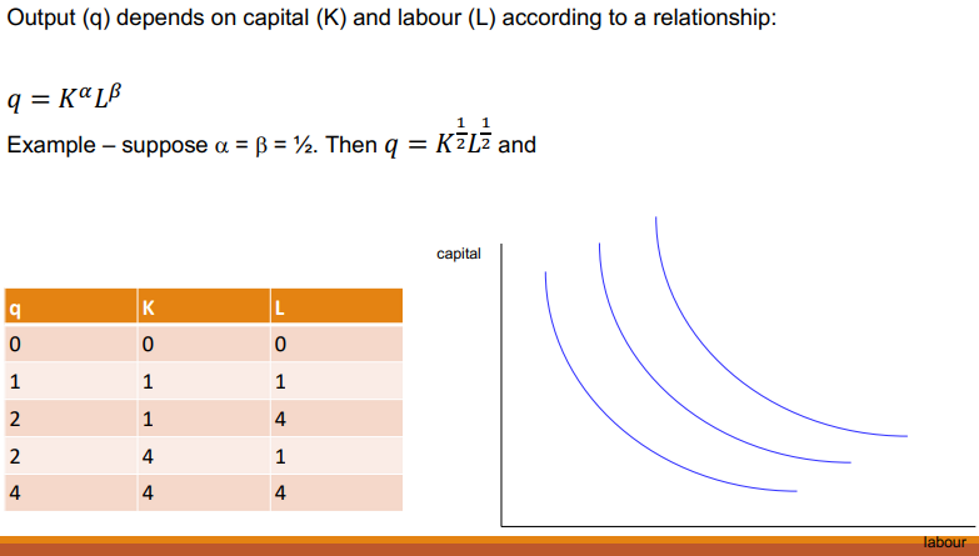
Isoquants
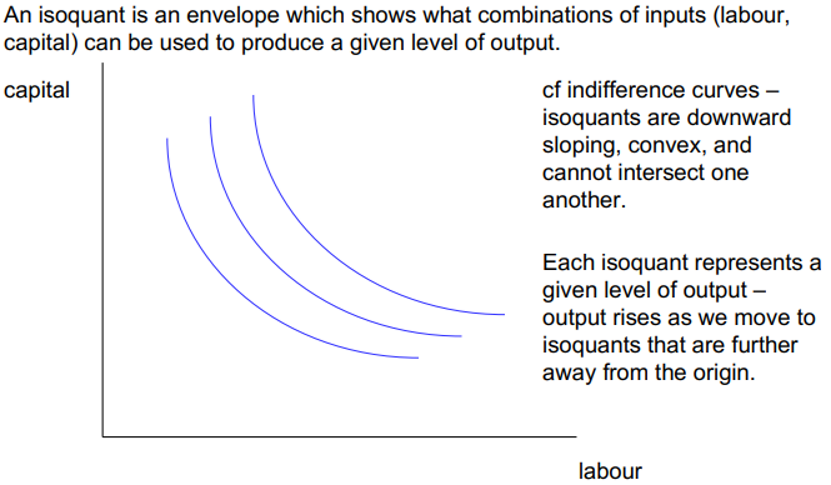
What does a Higher Isoquant mean?
higher output level
Marginal Rate of Technical Substitution (MRTSL,K)
the rate at which the firm can trade labour (L) for capital (K), holding the output constant
it’s the (negative of) slope of the isoquant

Special Cases of Isoquants
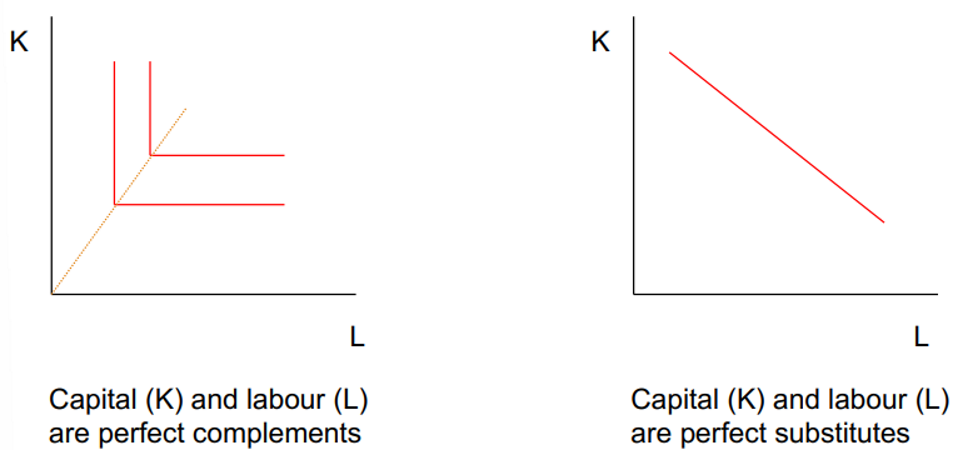
Returns to Scale
a change in the amount of output in response to a proportional increase of the inputs
Constant Returns to Scale
happens if changing the amount of capital and labour by some multiple changes the quantity of output by exactly the same multiple
doubling labour and capital doubles output
Increasing Returns to Scale
happens if changing the amount of capital and labour by some multiple changes the quantity of output more than proportionally
doubling labour and capital more than doubles output
Decreasing Returns to Scale
happens if changing the amount of capital and labour by some multiple changes the quantity of output less than proportionally
output does not fully double when inputs are doubled
Technology Change (Total factor productivity growth)
an improvement in technology that changes the firms production function such that more output is obtained from the same amount of inputs

Cost Formulae
Total cost = fixed cost + variable cost
Fixed cost – fixed input — capital – r (rental rate)
Variable cost – variable input — labour – w (wage rate)
What determines the shape of Total Costs in the Short-Run?
the law of diminishing marginal product
Average Costs
total cost / output
in the short run it will decrease at first as the fixed cost needs to be spread - as you produce more it will increase
Marginal Cost
the cost of producing another unit of output
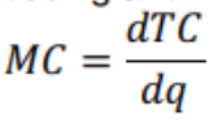
Long Run Cost Minimisation
firms choose K and L to maximise production efficiency
cost minimization: economically efficient input combination for a given q
Isocost lines (comparing to budget constraint)
Cost = V(K) + W(L)
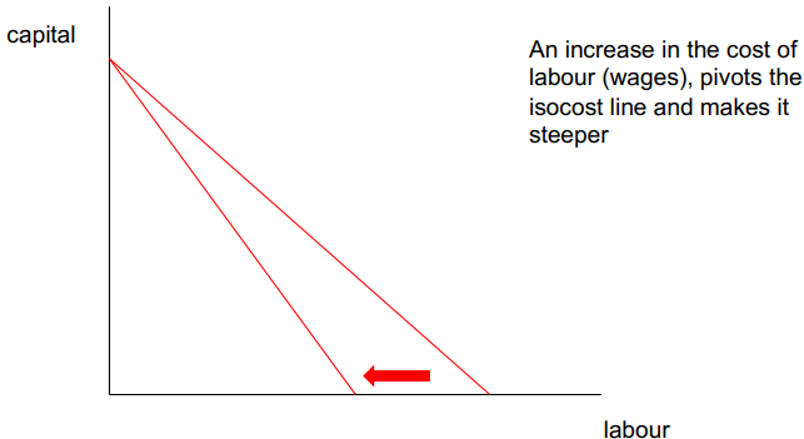
Isocost Lines
shows what combinations of the two inputs can be employed for a given cost

Isoquants and Isocost Lines
shows what combinations of the two inputs can be employed for a given cost
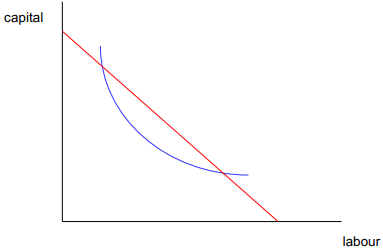
Isoquants and Isocost Lines: Cost Minimisation
tells us how cheaply it is possible to produce a given level of output – and what is the best combination of inputs to use
The key point is at tangency between a given isoquant and the lowest attainable isocost line
MRTS = w/r
Conditions (comparing to optimal consumption)

Cost Curves in the Long Run
In the long run, firms can vary the amount of capital they employ. They can therefore shift onto different short run cost curves. Owing to economies of scale, and subsequent diseconomies of scale, the long run average cost curve is an envelope around short run average cost curves:
The long run marginal cost curve passes through the minimum of the long run average cost curve
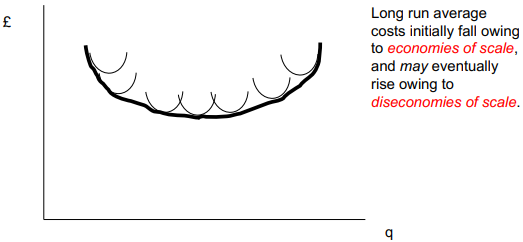
Economies of Scale
if doubling output causes cost to less than double
total cost rises at a slower rate than output rises
may be due to: fixed costs; specialisation; quality of machinery
Diseconomies of Scale
if doubling output causes cost to more than double
total cost rises at a faster rate than output rises
may be due to: managerial diseconomies / bureaucracy; geographical diseconomies
Constant Economies of Scale
if doubling output causes cost to double
total cost rises at the same rate as output rise